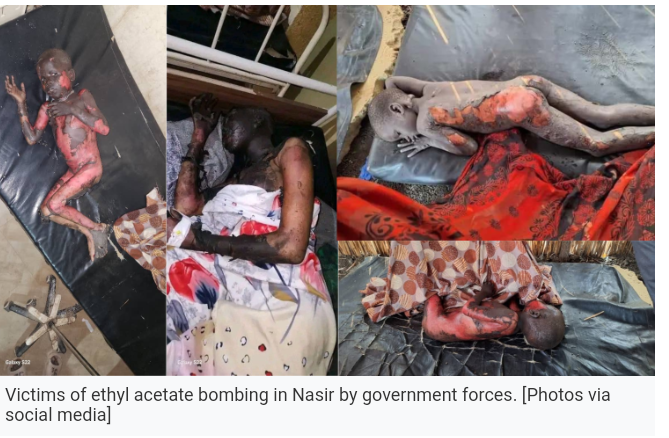An independent media investigation has pointed to the evidence of the deployment of ethyl acetate, a highly flammable chemical compound by the South Sudan defense Forces, in a targeted strike on the Nasir airstrip and market.
A devastating attack on Nasir, the capital of Nasir County of South Sudan’s Upper Nile State on Sunday left at least 15 people dead, including a community chief, Puol Bol Pet, and raised serious concerns about the use of incendiary weapons.
While initial claims suggested the use of cluster bombs, an investigation has rather revealed evidence pointing to the deployment of ethyl acetate, a highly flammable chemical compound
The attack triggered a fierce blaze, and graphic images circulating online depict numerous victims suffering severe burns and wounds consistent with exposure to intense fire.
These images, combined with the rapid spread and intensity of the fire, prompted speculation about the use of cluster munitions, which are banned under international law.
Cluster munitions, known for their indiscriminate nature and long-lasting threat from unexploded bomblets, are prohibited by the 2008 Convention on Cluster Munitions.
While over 120 countries have signed the treaty, major military powers, including the United States, Russia, and China, have not.
Initial claims of cluster bomb usage, reminiscent of allegations against the South Sudan government and its ally Uganda during the 2013 civil war, could not be substantiated.
However, media investigation uncovered compelling evidence of ethyl acetate (C₄H₈O₂) involvement.
Ethyl acetate is a volatile, flammable liquid with a low flash point. Its vapors form explosive mixtures with air and, being heavier than air, can spread rapidly along the ground, intensifying fires.
This characteristic aligns with the reported spread and intensity of the Nasir fire.
The source of the ethyl acetate raises further questions. Photos of the containers circulating on social media bear the logo of Laxmi Organic Industries Ltd., an India-based specialty chemical company.
While neither South Sudan nor Uganda produces ethyl acetate, Uganda imports significant quantities of chemicals from various countries, including India.
According to World Integrated Trade Solutions, India is a major exporter to Uganda, with imports rising significantly in 2024.

Sudans Post sources provided photographic evidence of ethyl acetate barrels at the attack site, confirming their presence during the strike.
The South Sudanese government has also confirmed the attack, indicating its intentional nature, but stopped short of confirming use of the chemical compound.
The exact delivery method of the ethyl acetate remains contested.
Locals have offered conflicting accounts, with some suggesting drone strikes and others pointing to Antonov aircraft.
The weight of the 210-kilogram ethyl acetate barrels makes drone delivery over long distances unlikely.
The deployment of Ugandan forces to Juba on March 11, confirmed by both the South Sudanese and Ugandan governments, as well as the UPDF’s top commander, fuels speculation about their potential involvement.
The UPDF commander, and son of Museveni, stated the deployment aimed at rescuing the South Sudan president from rebels.
International humanitarian law, including the 1980 Convention on Certain Conventional Weapons and customary principles, strictly regulates the use of incendiary weapons.
Protocol III of the CCW explicitly prohibits their use against civilians and restricts their deployment near civilian populations.
Key tenets such as distinction, proportionality, and humanity demand that attacks target only military objectives and avoid excessive civilian harm.
The confirmed deployment of Ugandan People’s Defence Forces (UPDF) in South Sudan, as stated by both governments and UPDF’s top commander, adds a layer of complexity to the incident, raising questions about potential international legal responsibilities.
The legality of using ethyl acetate, a substance not primarily designed as an incendiary weapon, is determined by its deployment.
If used to deliberately or indiscriminately target civilians, causing widespread fires and uncontrollable damage, it violates international law.
Given the intentional nature of the strike, the confirmed Ugandan military involvement, and the confirmed civilian casualties the incident raises serious concerns regarding compliance with international legal standards and the protection of civilians.

